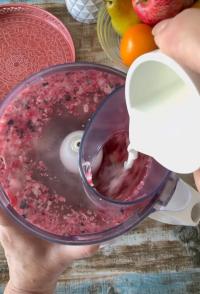Copy Link
Add to Bookmark
Report
Mead Lovers Digest #0959

From: mead-request@talisman.com
Errors-To: mead-errors@talisman.com
Reply-To: mead@talisman.com
To: mead-list@talisman.com
Subject: Mead Lover's Digest #959, 29 September 2002
Mead Lover's Digest #959 29 September 2002
Forum for Discussion of Mead Making and Consuming
Dick Dunn, Digest Janitor
Contents:
Acid and pH questions (Rick Dingus)
Additions to Secondary Ferment Question (Making up volume in secondary (M...)
elderbrries and small bottles ("Micah Millspaw")
Re: Info on starting a meadery (Phil)
Re: 6ounce bottles (Phil)
6-oz crown cap bottles & Mead Ice Cream ("Brian McGovney")
Small 6 oz bottles ("David Craft")
RE: Silliest Question in the World ("Kemp, Alson")
small bottles (LJ Vitt)
Small bottles ("Mary Johnson")
Re: Mead Lover's Digest #958, 26 September 2002 (Rick Dingus)
RE: Mead Lover's Digest #958, 26 September 2002 ("Elyusian")
Re: Mead Lover's Digest #958, 26 September 2002 (NatanTgrei@aol.com)
NOTE: Digest appears when there is enough material to send one.
Send ONLY articles for the digest to mead@talisman.com.
Use mead-request@talisman.com for [un]subscribe/admin requests.
Digest archives and FAQ are available at www.talisman.com/mead. There is
a searchable MLD archive at hubris.engin.umich.edu/Beer/Threads/Mead
----------------------------------------------------------------------
Subject: Acid and pH questions
From: Rick Dingus <rick.dingus@TTU.EDU>
Date: Fri, 27 Sep 2002 01:16:52 -0500
I'd appreciate any feedback on the following questions:
1. I read somewhere that adding 1 tsp. of citric acid to a mead is
equivalent to adding 2 tsp. of acid blend. Is that true or not? If so,
does that refer to pH, titration, or the subjective perception of citric
acid's sharper taste?
2. If ascorbic acid is used to preserve fruit color and/or reduce oxidizing
in a finished mead, should its affect on the overall acidity be taken into
account? Will boiling or pasteurizing the ascorbic acid alter its effect?
3. I'm confused about the relationship and difference between acid
titration and pH, as well as how much leeway there is for good fermentation
and good taste with varied levels of acid. I once purchased a titration
kit and carefully adjusted the acid in a grape wine only to find later that
the kit was old and the weakened testing solution had caused me to add way
too much acid. Is the acid level in mead as important as the acid level
supposedly is in grape wine? Can anyone clarify my confusion about
titration vs. pH, and whether or not its even worth the effort to test? (If
so, what's the best method?)
Thanks much.
Rick Dingus
------------------------------
Subject: Additions to Secondary Ferment Question (Making up volume in secondary
From: Michael Kaiser <kaiseriron2@yahoo.com>
Date: Fri, 27 Sep 2002 02:13:18 -0700 (PDT)
>Subject: Additions to Secondary Ferment Question
>From: "David Beaver" <vertical@mcleodusa.net>
>Date: Sat, 21 Sep 2002 08:00:25 -0600
>
>Can someone there advise me ?
>
>I have read many pages of internet instructions and recipies on mead
>making.
>I have not seen much info about adding anything to a secondary ferment
>(safely)
>to help make up volumes lost due to racking (losses).
>Is this a common practice ? How is low headspace maintained in the
>secondary
>fermenters due to losses.
>thanks for your time.
>
>David vertical@mcloedusa.net
David,
When I rack to secondary, and want to make up the headspace due to;
1. Excessive "Tasting" (how can you resist sometimes?)
2. Loss of volume due to racking off of fruit, additives, etc.
3. Sloppy handling of the product, usually due to #1 above.
I use glass marbles, bought from the "dollar store". They are inexpensive
(guess how much they are), can be sterilized by either boiling or using
an Iodine solution, are reusable, and have the secondary application of
helping to clean the carboy after fermentation ... just swoosh the
leftover lees/marble mixture around inside the carboy, and dump into a
strainer. They are also helpful in removing crud from old bottles ...
just add some to the bottle, add some cleaner, and swoosh around. The
glass marbles act like little scouring pads to scrape off any residues
inside the container. As to the concern of the marbles scratching the
glass of your prized carboy or favorite EZ-Cap container, not to worry.
These inexpensive glass marbles seem to be a lot "softer" than the glass
of a carboy or any other container, as they are sold as decoration only.
(for floral arrangements)
Buy about 20 packs of marbles for enough volume displacement. It's a
small investment that you will find rather usefull.
Just be careful when adding the glass marbles to the secondary
fermentation vessel, you dont want to add them too fast, or you risk (or
at least I always feel like I risk) damaging the glass of both the
marbles and the container, and adding minute shards of glass to your
mead. After using the same marbles for about 6 years, mine are still
scratch-free, and my carboys are still clear as a bell.
As a side note, I have fermented with as much as 20% of total volume
"open" (i.e. headspace) with no ill effects or off-flavors. As stated
before, if the must is still active when you transfer to the secondary, a
layer of CO2 will form rapidly in the new container, sealing the must
away from too much oxygen ... so if the amount of headspace is not too
great, don't sweat it, just let it ferment.
Michael Kaiser
Artist/Blacksmith/Webmaster/Mead Brewer
=====
http://www.spoutwood.com
http://www.fairiefestival.net
"Who loves not woman, wine and song remains a fool his whole life long."
- -Martin Luther
"An uair a theld an gohainn aer bhath 'se is dearr a bhi reidh ris."
When the Smith gets wildly excited 'tis best to agree with him.
- -Gaelic proverb
------------------------------
Subject: elderbrries and small bottles
From: "Micah Millspaw" <MMillspa@silganmfg.com>
Date: Fri, 27 Sep 2002 07:25:04 -0500
THe only small crown finish bottles that I know of are Martinelli's
sparkling apple juice they do (or did) a 6 3/4 oz green bottle.
It should be possible to find old Thomas Hardys 'nip' size bottles
as well as they no longer are produced, the supply may be limited.
>Subject: Re: Mead Lover's Digest #957, 24 September 2002
>From: JayAnkeney@aol.com
>Date: Tue, 24 Sep 2002 13:45:55 EDT
>What a great digest! I have a general question. Most competitions say you can
>enter your meads in bottles as small as 6 oz. Does anyone know how to find
>bottles that small which can securely take a crown cap?
Someone asked about elderberries being poison. And no the ripe fruit is
not. In fact elderberries are known to have anti viral properties and are
thought to mitigate the effects of the flu. The leaves can also be used for
a poultice (they don't taste good though).
BTW I had a glass of my elderberry / black berry mead the other day, it
was very good and is retaining colour well, and as a added bonus,
I was not poisoned by it.
Micah Millspaw -
------------------------------
Subject: Re: Info on starting a meadery
From: Phil <dogglebe@yahoo.com>
Date: Fri, 27 Sep 2002 05:42:54 -0700 (PDT)
Subject: info on starting a meadery
From: Chris Johnson <cjohnson@anim.dreamworks.com>
Date: Tue, 24 Sep 2002 09:43:40 -0700
Hello fellow Mead makers!
Trying to get some info on selling mead and starting
up a meadery
business. Is it impossible with all the paper work?
How many cases
would one need to produce per year in order to stay
above water?
A friend (and someone on the MLD has been researching
opening up a meadery. More of your time and money
will be spent on legal fees than anything else.
A would-be meadery on Long Island has been trying to
open for years. Supposedly, those involved are trying
to do all the paperwork themselves. They've been
promising to open for years.
In regards to how much you'll need to produce to make
a profit, that all depends on how big of a meadery you
plan on opening.
Phil
=====
visit the New York City Homebrewers Guild website:
http://www.homebrewersguild.org
------------------------------
Subject: Re: 6ounce bottles
From: Phil <dogglebe@yahoo.com>
Date: Fri, 27 Sep 2002 05:46:36 -0700 (PDT)
> Most competitions say you can enter your meads in
> bottles as small as 6 oz. Does anyone know how to
> find bottles that small which can securely take a
> crown cap?
Budweiser nips are 7 ounce bottles. The only place
you can really get them, though, is from bars.
Distributors generally don't sell opr collect them.
Phil
=====
visit the New York City Homebrewers Guild website:
http://www.homebrewersguild.org
------------------------------
Subject: 6-oz crown cap bottles & Mead Ice Cream
From: "Brian McGovney" <brian_mcgovney@yahoo.com>
Date: Fri, 27 Sep 2002 09:06:49 -0700
Hi there,
In response to Jay's question: I found a case of 187 ml (6.3 fl oz) bottles
with standard tops for crown-capping at Culver City Homebrew Supply just
last week. They only had one case left on the shelves, and they don't have
identifying marks, but maybe they know how to find more?
Also, I keep meaning to post this recipe, so here goes. Note they don't
actually use mead for this, but I'm sure we can all rig up a substitution.
:)
MEAD ICE CREAM
(Source: The Ultimate Ice Cream Book, by Bruce Weinstein, William Morrow &
Co., Inc., 1999, p. 68)
0.5 cup mild honey
6 large egg yolks
1.5 cups milk
1 cup heavy cream
1 tsp. vanilla extract
0.25 cup whiskey
Use a light-colored honey for this ice cream: perhaps clover, orange
blossom, heather, or wildflower [NOTE: Original author must not know much
about honey, as he actually recommends rhododendron, which as we know can be
POISONOUS!! - brian] Darker honeys such as chestnut, pine, and rosemary are
too strong and can easily overpower this delicate dessert.
In a medium mixing bowl, beat the honey with the egg yolks until thickened
and pale yellow. Set aside.
Bring the milk to a simmer in a heavy medium saucepan. Slowly beat the hot
milk into the eggs and honey. Pour the entire mixture back into the pan and
place over low heat. Stir constantly with a whisk or wooden spoon until the
custard thickens slightly. Be careful not to let the mixture boil or the
eggs will scramble. Remove from the heat and pour the hot honey custard
through a strainer into a large, clean bowl. Allow the custard to cool
slightly, then stir in the cream and vanilla. Cover and refrigerate until
cold or overnight.
Stir the whiskey into the chilled custard, then freeze in 1 or 2 batches in
your ice cream machine according to the manufacturer's instructions. When
finished, the ice cream will be soft but ready to eat. For firmer ice cream,
transfer to a freezer-safe container and freeze at least 2 hours.
------------------------------
Subject: Small 6 oz bottles
From: "David Craft" <chsyhkr@bellsouth.net>
Date: Fri, 27 Sep 2002 13:22:11 -0400
Greetings,
The Grape and Granery sells small "nip" bottles, about 6 oz and green in
color. They take crown caps. I think they had a deal on shipping when our
club ordered them. A local dealer may be able to get them from Carlson or
some other supplier.
We have used them for Barleywine and some mead.
David B. Craft
Battleground Brewers Homebrew Club
Crow Hill Brewery and Meadery
Greensboro, NC
------------------------------
Subject: RE: Silliest Question in the World
From: "Kemp, Alson" <alson.kemp@cirrus.com>
Date: Fri, 27 Sep 2002 11:55:23 -0700
Vuarra,
>At what point do I know when the mead is *done*?
>[W]hen is it ready for consumption?
Simple answer: taste it. Get a wine thief and pull a few
mL from the carboy. See how you like it with a few grains of
sugar or acid blend. After you make a few batches of mead,
you'll get used to what you like and don't like.
Recommendation for a newbie: make a bunch (10-15) of 1-2L
batches with different yeasts, different honeys, different
sweetnesses, different acid. Take excellent notes. Ferment them
to completion (2 weeks) and then place the 1L batches in the
fridge to settle them. After a few days, pour off a few ounces
and taste them. Note the ones that you don't like and the ones
that you do like. Then make a 5G batch using the yeast, honey
and acid that you liked the most.
My brewing partner and I have made countless test
batches. In the short term, they're a waste of money because we
wound up pouring immature mead down the drain. In the long term,
we saved money because we learned what we liked and what we
didn't like.
-Alson
------------------------------
Subject: small bottles
From: LJ Vitt <lvitt4@yahoo.com>
Date: Fri, 27 Sep 2002 12:15:34 -0700 (PDT)
In MLD#958, Jay Ankeney asked about finding bottles as small as 6 oz.
I have used 7 oz used bottles from Anchor Old Fog Horn - its a barley
wine, and other barley wines that come in small bottles (older Thomas
Hardy's, I can't name any others), 25cl Fischer d'Alsace (8 oz),
bottles from Morte Subite lambic. There are a few other Belgian beers
in such little bottles.
=====
Leo Vitt
Rochester MN
------------------------------
Subject: Small bottles
From: "Mary Johnson" <mpmarus@hotpop.com>
Date: Fri, 27 Sep 2002 16:06:34 -0500
You can bottle still mead in barleywine bottles; but if you have sparkling
mead or potential ongoing fermentation, you'll need champagne splits. I
get mine from http://www.breworganic.com/. I bottled a slightly sparkling
cyser in them and they took a regular crown cap, as do the barleywine
bottles.
Mary Johnson
brewer, meadmaker, computer geek
citronelle, al
>------------------------------
>
>Subject: Re: Mead Lover's Digest #957, 24 September 2002
>From: JayAnkeney@aol.com
>Date: Tue, 24 Sep 2002 13:45:55 EDT
>
>What a great digest! I have a general question. Most competitions say you can
>enter your meads in bottles as small as 6 oz. Does anyone know how to find
>bottles that small which can securely take a crown cap?
>
>Jay Ankeney
>220 39th St.
>Manhattan Beach, CA 90266
>(310) 545-3983
------------------------------
Subject: Re: Mead Lover's Digest #958, 26 September 2002
From: Rick Dingus <rick.dingus@TTU.EDU>
Date: Fri, 27 Sep 2002 17:05:42 -0500
Subject: Barrel aging and oak soakers
From: Michael Kaiser <kaiseriron2@yahoo.com>
Date: Tue, 24 Sep 2002 09:23:19 -0700 (PDT)
Vince Galet wrote:
>Subject: Barrel aging and oak soakers
>From: <vince@scubadiving.com>
>Date: Mon, 16 Sep 2002 12:40:05 -0400 (EDT)
>
>I tried commercial mead aged in oak, and it's nice. I'd love to try
>aging mead in an oak barrel, but I just don't have one. On the other
>hand, my supply store sells what they call "oak soakers" - round oak
>marbles to add in the fermenter to get some of the barrel flavor (if you
>can't bring the mead to the barrel, bring some of the barrel to the
mead)
>
>I was wondering if anyone used that system or similar (i.e., wood chips)
>and would have comments to share, especially on how long to leave them
>in. Also, I suspect they may become bacteria redoubts and I was
>wondering what would be the best way to maintain them (if they are at
>all reusable).
Another method of using oak that I like is to make an extract from oak with
vodka. I buy oak chips at a homebrew shop and measure out enough to fill
half of a quart sized mason jar. I steam those oak chips for 20 minutes
with a vegetable steamer to sanitize, and discard the water. Transfer the
chips to a sanitized quart jar and fill it to the top with cheap vodka.
Shake a few times a day or when you think about it, and let it set a couple
of weeks or more (its not critical.) After a few weeks or months, remove
the chips by transferring the liquid to another jar while passing it through
a stainless steel kitchen strainer. Then strain through a coffee filter to
obtain clear oak extract. Test it in small samples of mead until you obtain
the desired amount of oak flavor and scale it up to whatever size batch you
want to add it to (i.e., 1/2 tsp. extract in 6 oz mead is about the same as
8.8 oz extract in five of gallons of mead.) It doesn't take much--a cup of
this highly concentrated oak extract will be noticeable in a five gallon
batch. The extract can be added at the end, just before bottling, or at any
time after fermentation is complete when you can begin to judge the flavors.
The same method can be used to make extracts from spices, herbs, fruit,
etc., although some berries are hard to strain without gumming up a coffee
filter (but if you mix the extract into the mead before the final racking,
any sediment that wasn't filtered out of the extract can settle in the
carboy before bottling.) Since the aromas and flavors have been extracted
directly by alcohol in the vodka, they are a bit different than those that
have passed through fermentation. Even if you prefer to ferment "on the
fruit", a small dab of extract at bottling can add a final adjustment or a
different twist of aroma, flavor, and complexity from the same fruit--like
adding the same spice at different stages of cooking, or, in beermaking,
adding the same hops for 60 minutes of boiling for bittering, 20 minutes for
flavor, and at the end for aroma.
Best,
Rick Dingus
------------------------------
Subject: RE: Mead Lover's Digest #958, 26 September 2002
From: "Elyusian" <ferret@wolfandferret.com>
Date: Fri, 27 Sep 2002 17:59:57 -0700
*------------------------------
*
*Subject: info on starting a meadery
*From: Chris Johnson <cjohnson@anim.dreamworks.com>
*Date: Tue, 24 Sep 2002 09:43:40 -0700
*
*Hello fellow Mead makers!
*Trying to get some info on selling mead and starting up a meadery
*business. Is it impossible with all the paper work? How many cases
*would one need to produce per year in order to stay above water?
*What state has the least amount of red tape with alcohol start up
*companies?
*Where is the best place to buy equipment on the larger scale? If
*anyone has looked at going into business before and has any info,
*positive or negative, please send me email. I live in California and I
*hear it is pretty impossible to get started. I'm willing to move to
*another state if need be. Then I have to find people with cash to help
*get this dream started(need help with that as well :-) ) I'm open to
all
*feedback you might have.
*Thanks
*Chris Johnson
*
I am in Washington State and it looks like, so far, the hardest part
would be the sanitation requirements. I am still in the recipe creation
stage (want to have good product going before I sink myself into
business loans and such) so I haven't researched too deeply, but what I
have seen is fairly lax and would be a breeze to set-up. The Seattle
area brims with small wineries that produce quality wines. Plus since
there is only 5 production meaderies in the state (and one really should
stick with wine and stop making mead), the field appears to bed wide
open.
http://seattlepi.nwsource.com/business/75131_urbanwine19.shtml
Jeff B.
- ---"A man is as young as the woman he feels."
- --- Groucho Marx
------------------------------
Subject: Re: Mead Lover's Digest #958, 26 September 2002
From: NatanTgrei@aol.com
Date: Sat, 28 Sep 2002 09:36:50 EDT
> What a great digest! I have a general question. Most competitions say you
> can
> enter your meads in bottles as small as 6 oz. Does anyone know how to find
> bottles that small which can securely take a crown cap?
>
Thats easy. IBC root beer can occasionally be found in little brown 7 oz
bottles, with an ungodly number of them per case( ithink 48 or 60). I've
found them at Tom Thumb, Publix and rarely at Winn Dixie. They will easily
take a standard bottle cap(like IBC uses on their bottles) and maintain
pressure just about forever. Check around at your local grocery stores
generally on the bottom shelf of the soda aisle.
Nathan C.
Ocala FL
------------------------------
End of Mead Lover's Digest #959
*******************************




























